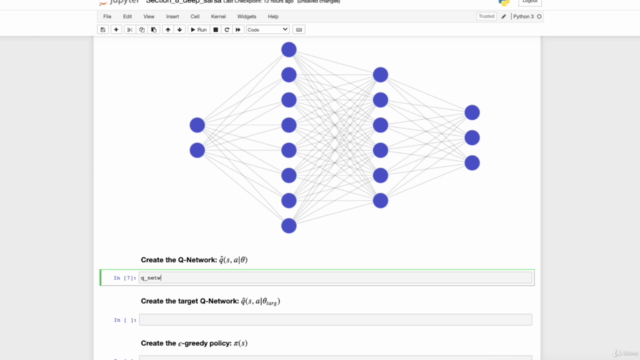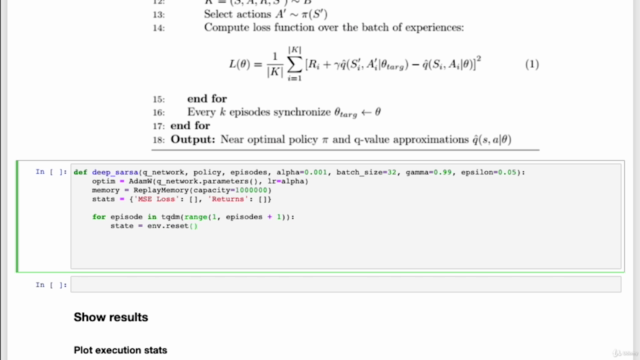Reinforcement Learning beginner to master - AI in Python

Why take this course?
🚀 Course Title: Reinforcement Learning Beginner to Master - AI in Python
🎓 Course Headline: Build Artificial Intelligence (AI) Agents using Deep Reinforcement Learning and PyTorch: A2C, REINFORCE, DQN, etc.
Unlock the Secrets of Reinforcement Learning with Escape Velocity Lab! 🌍🧠
Overview: This is the most complete Reinforcement Learning course on Udemy, meticulously designed to guide you from a beginner to a master in AI. You'll embark on a journey through one of the three pillars of modern artificial intelligence, where you'll unlock the power of adaptive algorithms that learn to solve control tasks based on experience. Dive into the exciting world of Deep Reinforcement Learning and neural networks, a combination that holds the key to some of the most sophisticated AI systems.
Why Take This Course? 🤔✨
- Comprehensive Foundation: Acquire a solid understanding of Reinforcement Learning concepts and algorithms, setting you up for mastery in the field.
- Practical Skills: Implement algorithms from scratch in Jupyter notebooks to build hands-on experience that stands out in your portfolio.
- Future-Proof Knowledge: Learn the principles behind emerging algorithms, ensuring you remain at the cutting edge of AI development.
- Advanced Exploration: This course serves as a springboard for our deeper dives into Reinforcement Learning's advanced topics and algorithms.
Course Structure: The course is conveniently structured into three parts to facilitate your learning journey. Each part focuses on different aspects of Reinforcement Learning, ensuring you have a well-rounded understanding by the end.
Part 1: Tabular Methods 📊
- Markov Decision Process (MDP): Understand the fundamental framework for making decisions under uncertainty.
- Dynamic Programming: Learn how to solve problems by breaking them down into simpler subproblems.
- Monte Carlo Methods: Explore random sampling techniques to approximate solutions to problems.
- Time Difference Methods: Get hands-on with SARSA and Q-Learning, two cornerstone algorithms for learning in part-known environments.
- N-step Bootstrapping: Enhance your understanding of temporal difference learning with this advanced technique.
Part 2: Continuous State Spaces 🌐
- State Aggregation: Learn how to deal with continuous state spaces by simplifying them into manageable chunks.
- Tile Coding: Discover methods for efficiently encoding high-dimensional state features into discrete representations.
Part 3: Deep Reinforcement Learning 🤖🧠
- Deep SARSA: Combine the strengths of neural networks with the SARSA algorithm to tackle more complex problems.
- Deep Q-Learning: Dive into the deep end with a neural network-based approach to learning the optimal action-selection policy.
- REINFORCE: Understand and implement this powerful algorithm for optimizing stochastic policies.
- Advantage Actor-Critic / A2C (A2C method): Master an efficient parallelized algorithm that combines both the advantages of actor-critic methods with deep learning techniques.
By the end of this course, you'll not only have a deep understanding of Reinforcement Learning but also be able to implement it effectively using PyTorch. You'll be equipped to tackle real-world problems and contribute to cutting-edge AI research and development. 🌟🚀
Enroll Now and Take Your First Step into the Future of AI! 📲🎓
Course Gallery




Loading charts...
Comidoc Review
Our Verdict
This Reinforcement Learning course offers a solid foundation in understanding RL concepts and algorithms for learners who are familiar with Python libraries or willing to troubleshoot outdated code. While it falls short on supporting beginners, the excellent presentation style—combining theory and practice—makes the learning experience engaging. Enroll if you're comfortable working through potential library compatibility issues in a quest to master Reinforcement Learning using Python.
What We Liked
- Covers a wide range of Reinforcement Learning concepts and algorithms
- Excellent presentation that balances theory and code implementation
- High-quality example code, great for practicing RL algorithms
- Clear explanations that break down complexities effectively
Potential Drawbacks
- Assumes high familiarity with various Python libraries
- Lacks guidance for beginners setting up and using Python libraries
- Some Q&A sections are ignored, leaving questions unanswered
- Outdated code examples cause compatibility issues with newer software versions